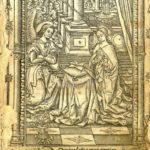Have you seen this Book of Hours? We need your help!
I came across this unidentified item while working my way through some French incunabula. It is a heavily illustrated, French Book of Hours which is wanting everything before leaf e1 and everything after leaf q8: i.e. it is virtually unidentifiable.
- Leaf e1r, the first page in TypFP.B00PH.
- Leaf l1r, with the mysterious “au”.
There were many types of printed Hours coming out of France at the end of the 15th and beginning of the 16th century, and many of them were illustrated in a similar fashion. It is assumed that this copy is missing its first 32 leaves (i.e. four gatherings of eight leaves) and probably its last 16. Previous work has suggested that this might be Philippe Pigouchet’s work, as he worked on other Hours for Simon Vostre at the end of the 15th century. Also, the elaborate woodcut borders depicting biblical scenes, the Virtues, the stag hunt, apple harvest and memento mori are similar to those found in other identified Pigouchet Hours. It is also thought to be an Hours in the use of Autun or Auxerre because of the otherwise unexplainable “au” at the foot of each page next to each signature mark (see images 13 and 19 in the gallery above).
If anyone can provide further information on this item, we would be very happy to hear it!
–DG





















"Deus in adiutorium meum" are words from Vespers ... "Levavi oculos meus" - from psalm, I raise my eyes to the hills, whence cometh my help "Sequunter septem psalmi penitentiali" Here follows the 7th penitential psalm If you Google the list of saints, you might be able to pinpoint a geographical location - Latin service books are often identifiable to a region. Thanks to Wikipedia I can tell you Sante Amator is "Saint Amator (French) Amadour or Amatre ... bishop of Auxerre" 14th or 15th century? So very many years since I did this, I don't think I'm a reliable witness!
Also, one of your illustrated saints' names pages mentions Foy http://standrewsrarebooks.files.wordpress.com/2011/12/typfp-booph-16.jpg there is an Abbey of Sainte-Foy http://www.sacred-destinations.com/france/conques-abbey
Most of the cuts were designed by Jean Pichore; see C. Zoehl, Jean Pichore: Buchmaler, Graphiker und Verleger in Paris um 1500, Turnhout, 2004. The other cuts were designed by the Master of the Apocalypse Rose; see I. Nettekoven, Der Meister der Apokalypsenrose und die Pariser Buchgraphik im 1500, Turnhout, 2004. These two books should also enable you to identify your particular edition.
When Marina Branscombe catalogued the incunabula, I remember doing quite a bit of work on this. As far as I recall, we decided that au stood for Auxerre, and that this is a usage of Auxerre. Thiswould tie up with your comment above.
I've had several messages in regards to this book, and due to the presence of Saints Amator and Regnobert in the calendar (both very local and obscure saints), we can almost safely say that this is, indeed, a usage of Auxerre. There are only two uses of Auxerre listed in Bohatta, H. "Livres d'Heures", nos. 26 or 27. The description on 26 is quite minimal, however the description of 27 doesn't quite match our copy (lists 22 lines per page, ours has 21), so I'm leaning towards this possibly being Bohatta 26. I'm still waiting on confirmation from some other sources, but thank you to all who have replied or looked at this post, it has been a great help!
This has come in from Martina Nickel via Dr. Falk Eisermann at the Gesamtkatalog der Wiegendrucke: "The edition is definitely from the workshop of Philippe Pigouchet, for Simon Vostre, and was printed in Paris. The types are 2:98G and 7:55G which were in use since before 1500; due to the woodcuts, borders and decoration the edition must have been printed between 1505 and 1508, however. The letters "au" and the mentioning of certain saints like S Germanus and S Palladius indicate that the Book of Hours was printed for the use of Auxerre. So this could be Bohatta 26, but as neither Bohatta nor Brunet give information about number of lines per page, about the origin of the copy they saw or knew, or about defects, it is impossible to identify the St Andrews as Boh.26 without any doubt." So, with everyone's help, we've been able to narrow this item down to a definite printer and publisher, a publication date range of three years, and a definite usage. I think this is as close as we could've hoped for without someone having another copy of this item, so thank you very much to everyone involved indeed!
[...] post last December on an unidentified French Book of Hours received a huge response and helped us to narrow down exactly which book it was. Based on its [...]
It is perhaps very late, but I found in my collection 2 leaves of the same kind as those above( TypFP.BOOPH04) They are of Thielman Kerver. He used the same illustrators ; Jean Pichore and the Master of Très Petites Heures of Anne of Brittany, or the same printing blocs.